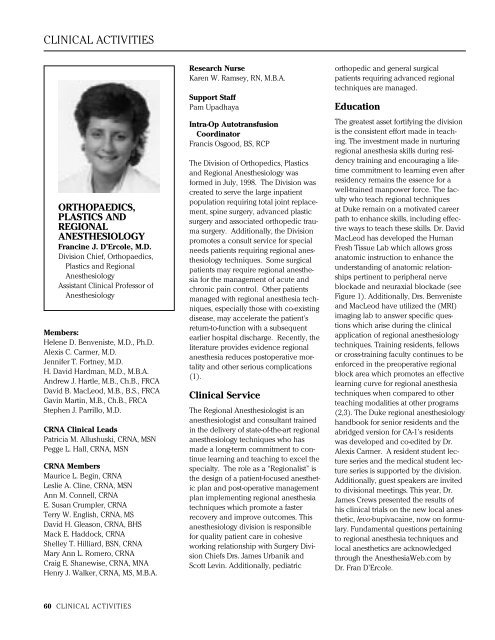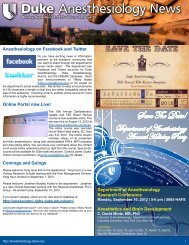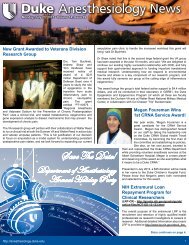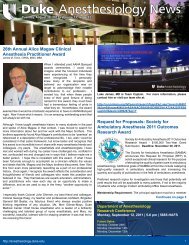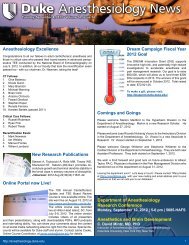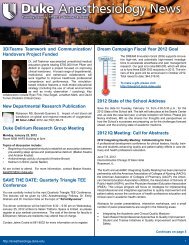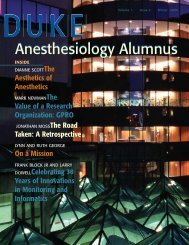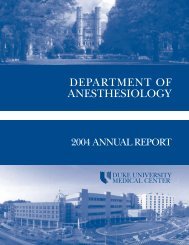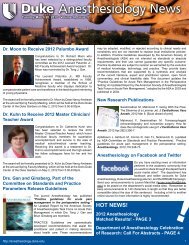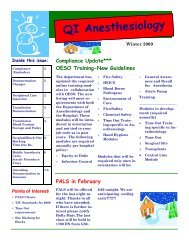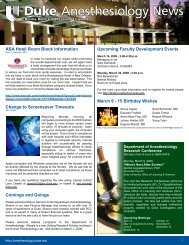DEPARTMENT OF ANESTHESIOLOGY ANNUAL REPORT
DEPARTMENT OF ANESTHESIOLOGY ANNUAL REPORT
DEPARTMENT OF ANESTHESIOLOGY ANNUAL REPORT
Create successful ePaper yourself
Turn your PDF publications into a flip-book with our unique Google optimized e-Paper software.
CLINICAL ACTIVITIES<br />
ORTHOPAEDICS,<br />
PLASTICS AND<br />
REGIONAL<br />
<strong>ANESTHESIOLOGY</strong><br />
Francine J. D’Ercole, M.D.<br />
Division Chief, Orthopaedics,<br />
Plastics and Regional<br />
Anesthesiology<br />
Assistant Clinical Professor of<br />
Anesthesiology<br />
Members:<br />
Helene D. Benveniste, M.D., Ph.D.<br />
Alexis C. Carmer, M.D.<br />
Jennifer T. Fortney, M.D.<br />
H. David Hardman, M.D., M.B.A.<br />
Andrew J. Hartle, M.B., Ch.B., FRCA<br />
David B. MacLeod, M.B., B.S., FRCA<br />
Gavin Martin, M.B., Ch.B., FRCA<br />
Stephen J. Parrillo, M.D.<br />
CRNA Clinical Leads<br />
Patricia M. Allushuski, CRNA, MSN<br />
Pegge L. Hall, CRNA, MSN<br />
CRNA Members<br />
Maurice L. Begin, CRNA<br />
Leslie A. Cline, CRNA, MSN<br />
Ann M. Connell, CRNA<br />
E. Susan Crumpler, CRNA<br />
Terry W. English, CRNA, MS<br />
David H. Gleason, CRNA, BHS<br />
Mack E. Haddock, CRNA<br />
Shelley T. Hilliard, BSN, CRNA<br />
Mary Ann L. Romero, CRNA<br />
Craig E. Shanewise, CRNA, MNA<br />
Henry J. Walker, CRNA, MS, M.B.A.<br />
60 CLINICAL ACTIVITIES<br />
Research Nurse<br />
Karen W. Ramsey, RN, M.B.A.<br />
Support Staff<br />
Pam Upadhaya<br />
Intra-Op Autotransfusion<br />
Coordinator<br />
Francis Osgood, BS, RCP<br />
The Division of Orthopedics, Plastics<br />
and Regional Anesthesiology was<br />
formed in July, 1998. The Division was<br />
created to serve the large inpatient<br />
population requiring total joint replacement,<br />
spine surgery, advanced plastic<br />
surgery and associated orthopedic trauma<br />
surgery. Additionally, the Division<br />
promotes a consult service for special<br />
needs patients requiring regional anesthesiology<br />
techniques. Some surgical<br />
patients may require regional anesthesia<br />
for the management of acute and<br />
chronic pain control. Other patients<br />
managed with regional anesthesia techniques,<br />
especially those with co-existing<br />
disease, may accelerate the patient's<br />
return-to-function with a subsequent<br />
earlier hospital discharge. Recently, the<br />
literature provides evidence regional<br />
anesthesia reduces postoperative mortality<br />
and other serious complications<br />
(1).<br />
Clinical Service<br />
The Regional Anesthesiologist is an<br />
anesthesiologist and consultant trained<br />
in the delivery of state-of-the-art regional<br />
anesthesiology techniques who has<br />
made a long-term commitment to continue<br />
learning and teaching to excel the<br />
specialty. The role as a “Regionalist” is<br />
the design of a patient-focused anesthetic<br />
plan and post-operative management<br />
plan implementing regional anesthesia<br />
techniques which promote a faster<br />
recovery and improve outcomes. This<br />
anesthesiology division is responsible<br />
for quality patient care in cohesive<br />
working relationship with Surgery Division<br />
Chiefs Drs. James Urbanik and<br />
Scott Levin. Additionally, pediatric<br />
orthopedic and general surgical<br />
patients requiring advanced regional<br />
techniques are managed.<br />
Education<br />
The greatest asset fortifying the division<br />
is the consistent effort made in teaching.<br />
The investment made in nurturing<br />
regional anesthesia skills during residency<br />
training and encouraging a lifetime<br />
commitment to learning even after<br />
residency remains the essence for a<br />
well-trained manpower force. The faculty<br />
who teach regional techniques<br />
at Duke remain on a motivated career<br />
path to enhance skills, including effective<br />
ways to teach these skills. Dr. David<br />
MacLeod has developed the Human<br />
Fresh Tissue Lab which allows gross<br />
anatomic instruction to enhance the<br />
understanding of anatomic relationships<br />
pertinent to peripheral nerve<br />
blockade and neuraxial blockade (see<br />
Figure 1). Additionally, Drs. Benveniste<br />
and MacLeod have utilized the (MRI)<br />
imaging lab to answer specific questions<br />
which arise during the clinical<br />
application of regional anesthesiology<br />
techniques. Training residents, fellows<br />
or cross-training faculty continues to be<br />
enforced in the preoperative regional<br />
block area which promotes an effective<br />
learning curve for regional anesthesia<br />
techniques when compared to other<br />
teaching modalities at other programs<br />
(2,3). The Duke regional anesthesiology<br />
handbook for senior residents and the<br />
abridged version for CA-1’s residents<br />
was developed and co-edited by Dr.<br />
Alexis Carmer. A resident student lecture<br />
series and the medical student lecture<br />
series is supported by the division.<br />
Additionally, guest speakers are invited<br />
to divisional meetings. This year, Dr.<br />
James Crews presented the results of<br />
his clinical trials on the new local anesthetic,<br />
levo-bupivacaine, now on formulary.<br />
Fundamental questions pertaining<br />
to regional anesthesia techniques and<br />
local anesthetics are acknowledged<br />
through the AnesthesiaWeb.com by<br />
Dr. Fran D’Ercole.


